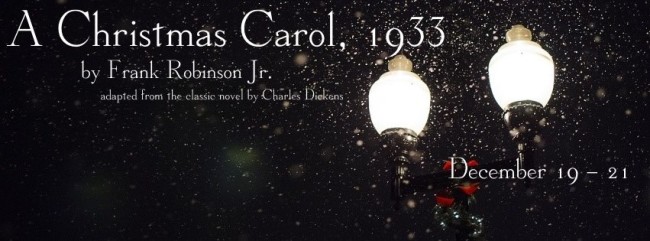The true power of theatre is to touch people’s lives and make them think, even just for a little while, a little less about their troubles. This time of year when people so keenly feel the troubles that surround them, Parlor Room Theater is working their power and their magic through a well-known Christmas story allowing audiences everywhere to feel the spirit of Christmas and forget about their troubles and their strife while indulging in a new adaptation of Dickens’ holiday classic. New material and adaptation by Frank Robinson Jr., this wondrous presentation of A Christmas Carol, 1933: A Live Radio Play is a precious examination of the way stories impact our hearts, especially during the holidays.
A radio studio in a fictitious town in 1933 on Christmas Eve in a blizzard; the setting sounds overdone, but Set Designer Ember DiSalvo keeps it simple; a homey effort that enables the audience to focus on the notion of the radio play. Props Master Thomas DiSalvo works in tandem with Sound Designer Robert Pike to create some of the more authentic moments that are featured throughout the “radio show” segments. From the rather impressive old-fashioned hand-crank wind machine, to the loaded step boards for “walking sound effects” DiSalvo and Pike create a symphony of effects that delivers that extra special sparkle to the production. The most striking moment of sound is the rolling growth of the gong as the “ghost of Christmas yet to come” arrives in the radio scene.
Ember DiSalvo also serves as the show’s Costume Designer, again keeping the focus light and simplistic. Sharp suits for the gentlemen with longer winter coats and dresses that are appropriate for the era. DiSalvo’s choice to focus on crisp pressed garments shows the true spirit of Christmas despite the characters are suffering in various ways from the fallout and aftermath of the Great Depression.
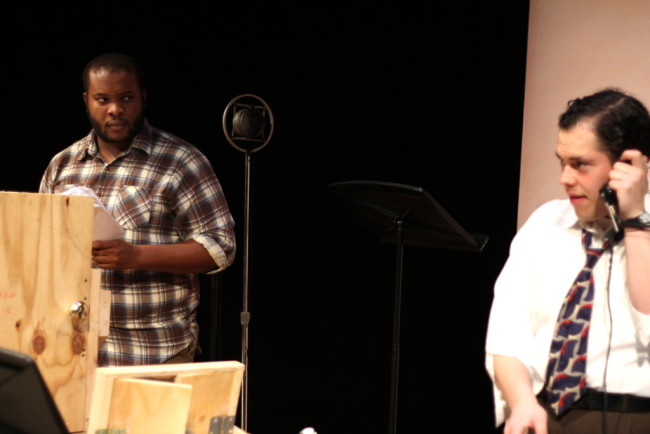
Frank Robinson Jr. has taken the concept of a Radio Play in live theatre— a notion that is all too often criticized for diminishing the true theatrical experience— and woven it soundly into an actual Christmas show that has both meaning and heart. The radio play itself is essentially an inverse framework; a catalyst for the players of the station to come together and share their hardships with one another at a time of year when burdens are meant to be forgotten and merriment is meant to be had. The parallels that Robinson draws between Dickens’ initial social agenda and the one experienced in the story that occurs in his show outside of the radio play are striking and a stroke of playwright genius. The moments where similarities within Dickens’ novel impact the characters playing out the radio play are stunning to behold and bring tender moments to brilliant life in the performance.
Robinson displays a sharp wit throughout; a cheeky essence to writing dialogue. Catchy phraseology like “Go ride a reindeer” and “Jesus, Mary, and Joseph” timed just after a holiday comment has been made are clever and humorous. These laugh-laden moments juxtaposed against the more severe gravity of the overall situation make Robinson’s writing exceptionally well rounded. The pacing of Robinson’s story, under the guidance of first-time Director Patrick Gorirossi moves fluidly. Gorirossi ensures that there is a difference in tempo between the radio-play scenes and those existing outside of it.
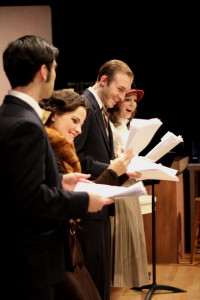
There are moments sprinkled throughout the production that if one does take to closing their eyes for just a second, the authentic feel of a real live radio play permeates the air. This is exceptional for all too often theatre companies get caught up in the theatricalization of a radio play— forgetting that the idea is to be a radio play. The action that occurs in this production outside of the radio play is in essence a separate story using the radio broadcast as an access point to the material. There are times when the actors in the radio play are standing a bit too still awaiting their go at the microphone, but this feels like a deliberate directorial choice from Gorirossi in the interest of consistency. Rather than arbitrary movement about the stage at that time adding to the potential calamity of a missed entrance, Gorirossi keeps them still, encouraging the audience to close their eyes just momentarily and have an honest listen.
The show’s only fault lies in the difference between the radio-play and non-radio-play scenes where sound execution from the actors in the radio-play is perfect, but speaking volume from them is not. They speak clearly and consistently when they are in the radio-play, but as characters talking outside of Dickens’ text they become far too soft to hear easily or trail off at the end of sentences. This note notwithstanding, Gorirossi makes an impressive directorial debut with the new adaptation.
Seven actors seems far too few to properly enact A Christmas Carol, though there are performances where one actor does all two-dozen of Dickens’ inspiring characters. Working together as an ensemble, these seven performers fit perfectly together to achieve a brilliantly funny and truly heartwarming tale this time of year. The most impressive accomplished feat that these seven performers pull off is their ability to continually create new accents on the spot. While some of them do meander a bit— like Bob Cratchit’s which takes a leisurely stroll all through the foothills of Scotland, Ireland and a few places in-between— it is refreshing to hear such talent living up to the notes laid down in the script, “anything but Golden Valley.”
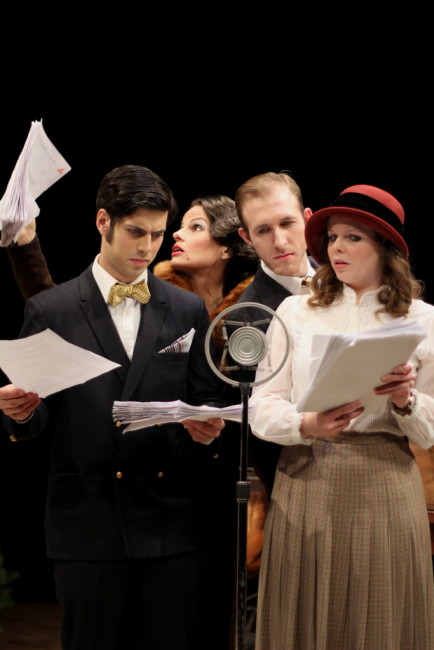
Jake Albright (Thomas DiSalvo) is the station manager; coordinator extraordinaire. DiSalvo portrays a frantic and harried character throughout the performance, which is rather an amusing juxtaposition against the other personality types that surface in the production. DiSalvo’s plethora of accents showcases his versatility as a performer as he takes on additional roles in the radio play in addition to flawlessly executing most of the sound effects throughout its duration.
Clarence Richmond (Lonnie Simmons) isn’t meant to be a part of the broadcast at all. Simmons’ character gets pulled into the radio play and does just as well as the rest with producing unique sounds for each of his characters. A striking moment of note is the bemoaning wails he creates as Jacob Marley; truly agonizing and loaded with the anguish that the long-dead spirit experiences in his ghostly plight.
Bow Charles (Dillon DiSalvo) is one of the more humorous characters with his sharp sarcasm and utter deadpan delivery when it comes to the enthusiasm over getting to play Tiny Tim and various other children. DiSalvo creates absurd voices for Tiny Tim which results in quite the hilarious faces of utter confusion from Rick Fox (Grayson Owen) the actor playing Bob Cratchit. DiSalvo provides an exceptional lower end range for the songs that are song, a wonderful pairing with Owen’s slightly higher bari-tenor sound.
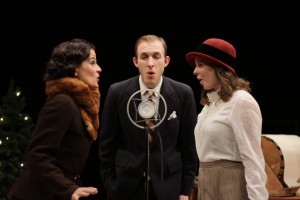
Owen, as the pinched and emotionally frigid lawyer character, actualizes the notions of Robinson’s connectivity the most. The infamous Belle/Scrooge parting scene hammers fiercely at Rick Fox’s heart and Owen’s emotional response of raw vulnerability is a testament both to his expressive ability and to Robinson’s concept layered into the writing. Like Dillon DiSalvo, Owen has the voice of a Christmas angel, particularly when leading off “The Holly and the Ivy” as well as the other Christmas Carols.
In every troupe of actors there’s always one who has the diva personality coated in sugar who waxes nostalgic and repeats herself often. In this production the character is Margaret Paddy (Kathryn Barrett-Gaines.) Not quite a has-been actor, Gaines’ approaches the character with vigor. Between the facial expressions and her delivery of the long rambling stories she creates the epitome of that faded-starlet personality in her portrayal. Her attempt to find the correct voice for Mrs. Cratchit is wildly entertaining. With a lovely singing voice, she and Mae (Erin Hanratty) even out the fellas in the songs quite nicely.
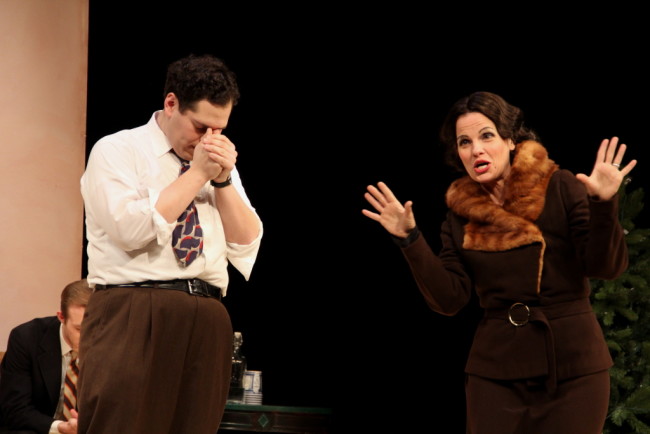
Hanratty, as the gentle, albeit chipper, ingénue-type character, brings a kindness to the show that is welcomed in the face of all the characters’ troubles. Hanratty’s finest moments are experienced during the radio play when she’s trying to play both Martha and Belinda Cratchit at the same time and convincingly, though not without a good deal of laughable effort, manages to make them sound different from one another.
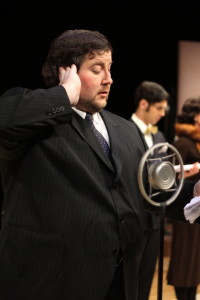
Perhaps the most versatile of the seven, though only ever getting to voice Scrooge, is Frankie Alexander (Christopher Williams.) With a voice as pure as the golden valley tones that ring out at the beginning and the end of the radio play, Williams’ announcer persona is as pristine as if he were a true 1930’s radio recording; rich and smooth and full of slow simmering holiday spirit. As the curmudgeonly old miser Williams delivers a harsh gravel that is so intense you would swear if you closed your eyes it was two different performers.
The show has an extremely limited run but should not be missed if possible.
Running Time: Approximately 1 hour and 45 minutes with one intermission
A Christmas Carol 1933: A Live Radio Play plays through December 21, 2014 with Parlor Room Theater at the Fine Arts Theater of Bishop McNamara High School— 6900 Marlboro Pike in Forestville, MD. Tickets are available for purchase at the door or in advance online.


